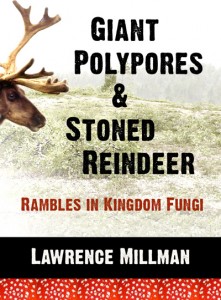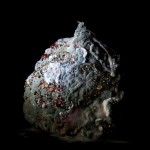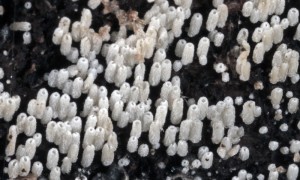It’s been so disturbingly dry and bereft of fungi here in the Northeast that I feel a strong sense of foreboding. At any moment, I expect to see the Five Horsemen of the Apocalypse galloping down the road toward me. Five Horsemen? That’s right, for the newest and most potentially dangerous Horseman of the Apocalypse is Climate Change.
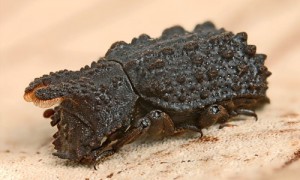
Mack is a Bolitotherus cornutus male.
In such difficult times, the fungally-deprived person can inspect horse dung for a fruiting of
Coprinus or wait until one of the Apocalyptic Horseman’s mounts dies, then examine its moldering hooves for
Onygena equina. Even better, perhaps, that person could look for an insect that makes perennial polypores its home as well as its breeding ground. I’m referring to the Horned or Forked Fungus Beetle (
Bolitotherus cornutus), a tenebrionid species far more pleasing to me than the so-called Pleasing Fungus Beetle.
A few months ago, I collected a male and female Bolitotherus on a Ganoderma applanatum in Vermont and brought them home for study. The male, Mack, has a pair of horns sprouting anteriorly from his pronotum, the better to thrust a competing male from his polypore home (big horns are probably good for mate selection, too), while the female, Sue, lacks horns. Otherwise, both look quite similar… like miniature medieval armored tanks. This morphology suggests that they could survive anything, perhaps even climate change. Their actual survival mechanisms consist of (1) rolling over and playing dead at the slightest provocation, and (2) releasing a benzoquinone defensive volatile in the direction of a breathlike air stream. I’ve tried to get Mack and Sue to release this volatile by breathing on them, but they’ve refused to do so. Maybe they like me…
Certainly, I like them. In the time I’ve spent studying them, they’ve exhibited an almost total absence of movement that seems almost zenlike. What can they be thinking about? Perhaps about nothing? That would be very zenlike, too. And whenever I watch them for any length of time, I start to move into a zenlike mode myself. Indeed, I would recommend that aficionados of meditation and Eastern religions seek out Bolitotherus cornutus for inspiration.
On at least one occasion, however, Mack and Sue were positively unzenlike. One night I woke up around 3am and couldn’t get back to sleep. All of a sudden I heard a peculiar rasping sound from Mack and Sue’s terrarium. I saw that the ventral surface of Mack’s abdomen was grating against the dorsal surface of Sue’s thorax. From what I’d read about the species, I knew that this was the position a male and female Bolitotherus assume prior to mating. And, sure enough, Mack and Sue were soon going at it with, for them, reckless abandon. I’ve been so delighted with the two of them as companions that I’m currently hoping that another generation of Bolitotherus will grace my abode.
For another, equally delighted response to Bolitotherus cornutus, please visit the Cornell Mushroom Blog, from which I have gratefully borrowed Kent Loeffler’s photo.
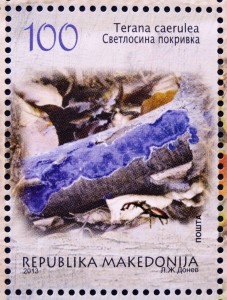 Not so long ago, I was visiting a stamp-collecting friend, and I happened to see the corticioid species Terana caerulea on a recent Macedonian stamp. A corticioid fungus on a stamp?? I was beside myself with astonishment, since corticioids (aka, crusts) are the outsiders of the fungal world, either despised or ignored. A mycophile of my acquaintance refers to them as “molds.”
Not so long ago, I was visiting a stamp-collecting friend, and I happened to see the corticioid species Terana caerulea on a recent Macedonian stamp. A corticioid fungus on a stamp?? I was beside myself with astonishment, since corticioids (aka, crusts) are the outsiders of the fungal world, either despised or ignored. A mycophile of my acquaintance refers to them as “molds.”
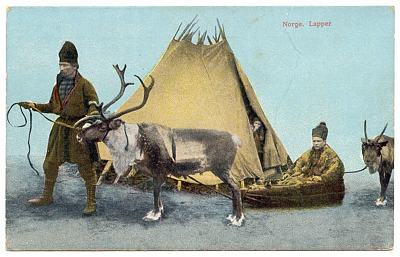 In the Middle Ages, Europeans had peculiar notions about Lapland. For instance, they thought all Samis (Lapps) were shamans. As it happens, many of them in fact were. Let’s say a sick person puts out a call for a noaidi (shaman). The noaidi would arrive at that person’s lodge in a reindeer-drawn sled. He would be obliged to enter via the chimney because the pile-up of snow prevents him from entering through the front door.
In the Middle Ages, Europeans had peculiar notions about Lapland. For instance, they thought all Samis (Lapps) were shamans. As it happens, many of them in fact were. Let’s say a sick person puts out a call for a noaidi (shaman). The noaidi would arrive at that person’s lodge in a reindeer-drawn sled. He would be obliged to enter via the chimney because the pile-up of snow prevents him from entering through the front door.